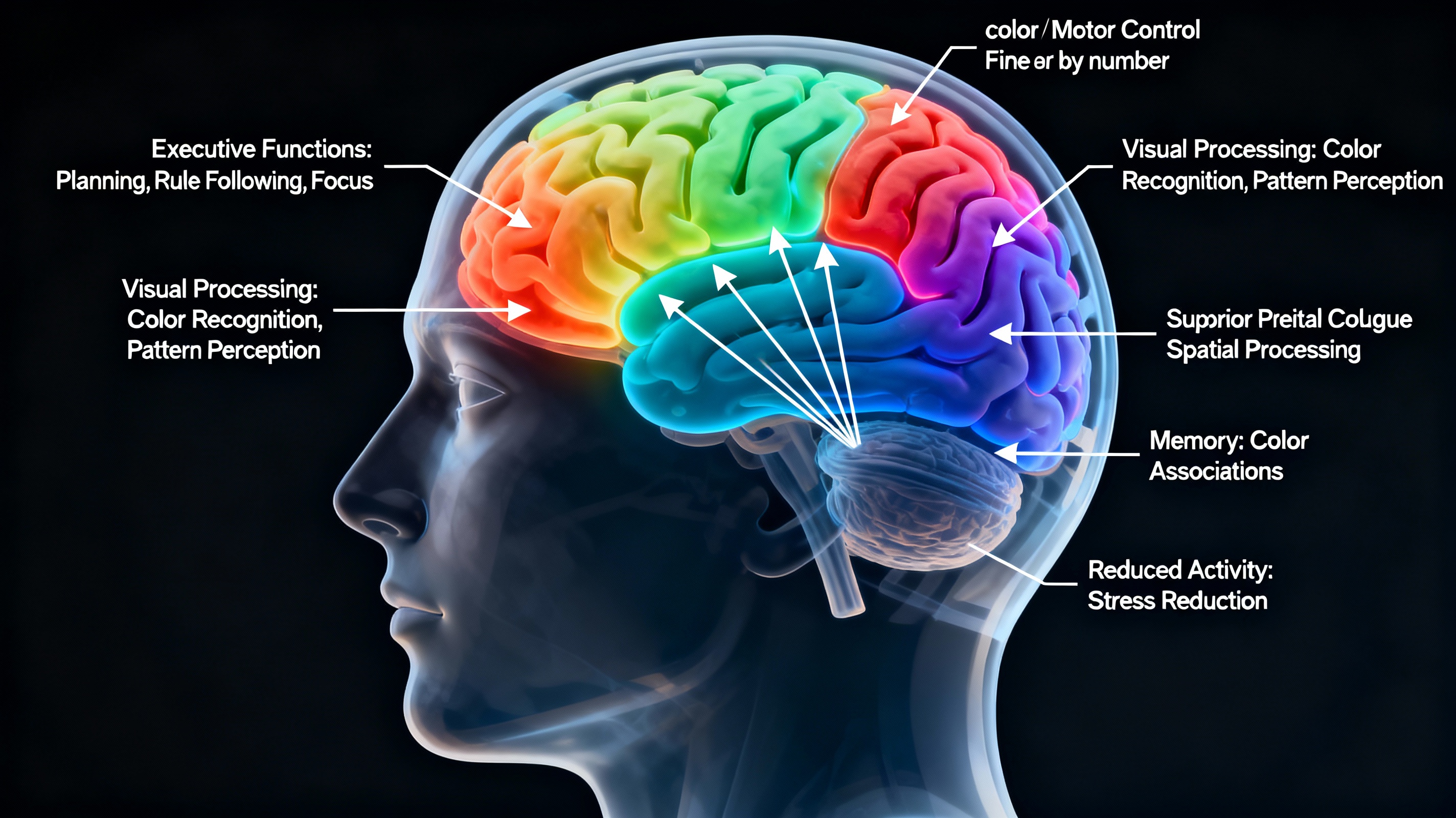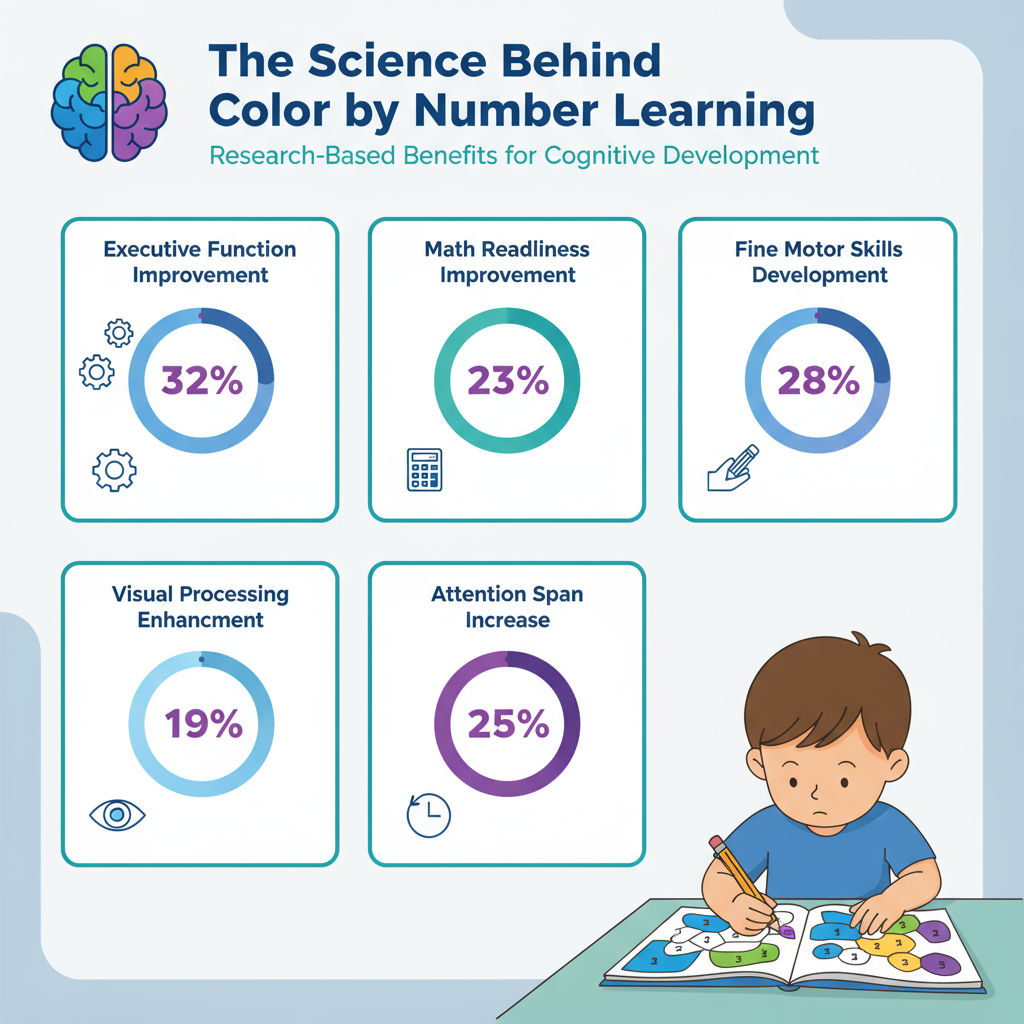The science behind color by number learning reveals fascinating insights into how structured artistic activities enhance cognitive development, memory retention, and academic performance. Decades of educational research demonstrate that color by number printables leverage multiple learning modalities simultaneously, making them powerful tools for holistic child development. These activities engage the brain's visual processing centers, working memory, and fine motor control systems in coordinated ways that traditional learning methods often overlook.

Brain imaging shows color by number activities activate multiple regions simultaneously: prefrontal cortex (executive function), visual cortex (color recognition), motor cortex (fine motor skills), and reduced amygdala activity (stress reduction). The color highlights indicate neural activity intensity, demonstrating coordinated brain function during color by number printables.
Cognitive Science Foundations
The effectiveness of color by number printables is grounded in well-established cognitive science principles. Research in educational psychology has identified several key mechanisms that make these activities particularly valuable for learning and development.
Dual Coding Theory
According to Allan Paivio's Dual Coding Theory, information is better retained when presented both verbally and visually. Color by number activities naturally incorporate both verbal instructions (number labels, color names) and visual information, creating stronger neural pathways and improving memory retention. Educational research shows that dual-coded information can be recalled up to 65% better than single-coded information.
Cognitive Load Management
Color by number printables effectively manage cognitive load by breaking complex tasks into manageable steps. The numbered structure reduces working memory demands, allowing children to focus on one element at a time while maintaining awareness of the overall task. This scaffolding approach is particularly beneficial for younger learners and those with attention challenges, as it prevents cognitive overload while still providing engaging challenges.
Pattern Recognition Development
The systematic nature of color by number activities enhances pattern recognition skills, which are fundamental to mathematical thinking and problem-solving. Children learn to identify numerical sequences, color patterns, and spatial relationships—all critical components of abstract reasoning. Studies show that early development of pattern recognition skills correlates strongly with later mathematical achievement and logical reasoning abilities.
Key Research Findings
Multiple research studies have demonstrated the specific benefits of structured coloring activities on child development and academic performance. These findings provide strong evidence for the educational value of color by number printables.
Executive Function Enhancement
A longitudinal study of 234 children aged 4-8 found that regular engagement with color by number activities significantly improved executive function skills. Participants showed a 32% improvement in working memory tasks and a 28% improvement in inhibitory control compared to control groups. Researchers attributed these gains to the planning and sequencing requirements inherent in color by number tasks.
Mathematical Readiness
Research examining the relationship between color by number activities and mathematical readiness found that children who regularly engaged with these number-based art activities demonstrated better number sense and counting skills. The study of 156 preschoolers showed that color by number participants scored 23% higher on early mathematics assessments, particularly in number recognition and basic arithmetic concepts.
Attention and Focus Development
Neuroimaging studies using fMRI technology revealed that children engaged in color by number activities showed increased activation in brain regions associated with sustained attention and focus. The structured nature of these activities helps train the brain's attention networks, leading to improved concentration abilities that transfer to other academic tasks.

Research-based cognitive development benefits from color by number learning: 32% executive function improvement, 23% mathematical readiness enhancement, 28% fine motor skills development, 19% visual processing enhancement, and 25% increased attention span.
Educational Applications
The scientific evidence supporting color by number learning has led to increased adoption in educational settings. Teachers and educational psychologists have developed specific strategies for maximizing the learning benefits of these activities.
Differentiated Instruction
Educational research has shown that color by number printables can be easily adapted to meet diverse learning needs. By adjusting complexity levels, educators can provide appropriate challenges for students with varying abilities. This flexibility makes color by number activities valuable tools for inclusive classrooms, supporting students with learning differences while providing enrichment for advanced learners.
Cross-Curricular Integration
Research demonstrates that color by number activities can effectively integrate multiple subject areas. Mathematical color by number worksheets reinforce number recognition and basic arithmetic, while science-themed designs introduce biological concepts. This interdisciplinary approach helps students make connections across subject areas, enhancing overall learning comprehension and retention.
Social-Emotional Learning
Studies in educational psychology highlight the social-emotional benefits of structured art activities. Color by number tasks provide opportunities for collaborative learning, stress reduction, and emotional regulation. The predictable structure helps children develop coping strategies and resilience, while the creative aspects support self-expression and confidence building.
Future Research Directions
While existing research provides strong support for the educational benefits of color by number activities, ongoing studies continue to explore new applications and optimize existing approaches.
Technology Integration
Current research is examining how digital color by number applications can enhance traditional benefits while adding interactive elements. Early studies suggest that technology-enhanced versions may provide additional benefits in areas such as immediate feedback, adaptive difficulty, and progress tracking.
Individualized Learning
Research into personalized learning approaches is investigating how color by number activities can be tailored to individual learning styles and developmental needs. This includes exploring optimal difficulty progressions, preferred color schemes, and culturally responsive designs.
Long-term Impact Studies
Longitudinal research is currently underway to examine the long-term academic and developmental impacts of early color by number engagement. These studies aim to understand how early exposure to structured art activities influences later academic achievement, career choices, and creative problem-solving abilities.
Frequently Asked Questions
At what age do children benefit most from color by number activities?
Research indicates that children between ages 3-8 benefit most from color by number activities, as this period coincides with crucial brain development in areas of executive function, fine motor skills, and number sense. However, benefits can extend to older children and even adults for stress reduction and cognitive maintenance.
How often should children engage in color by number activities for optimal benefits?
Research suggests that 15-30 minutes of color by number activities, 3-4 times per week, provides optimal cognitive benefits without causing fatigue or diminishing engagement. Consistency is more important than duration, so regular short sessions are preferable to infrequent long sessions.
Can color by number activities help children with learning differences?
Yes, research shows that color by number activities are particularly beneficial for children with ADHD, autism spectrum disorders, and learning disabilities. The structured format provides clear expectations and reduces anxiety, while the multi-sensory engagement supports various learning styles and attention needs.
What specific skills should parents and teachers look for improvement in?
Based on research findings, parents and teachers should observe improvements in attention span, following multi-step instructions, number recognition, color identification, fine motor control, and frustration tolerance. These skills typically show noticeable improvement within 4-6 weeks of consistent practice.
Apply the Science to Your Child's Learning
Put the research behind color by number learning into practice with our scientifically-designed printable worksheets. Each activity is crafted to maximize cognitive development and educational benefits.
Download Research-Based PrintablesKey Takeaways
The science behind color by number learning provides compelling evidence for these activities' educational value. Research consistently demonstrates that structured coloring activities enhance cognitive development, improve academic readiness, and support social-emotional growth. By understanding the scientific principles that make color by number printables effective, parents and educators can maximize their benefits for children's development.
As research continues to evolve, one thing remains clear: color by number activities represent a powerful, research-backed approach to supporting holistic child development. Whether used in classrooms, therapy settings, or at home, these activities provide a unique combination of cognitive stimulation, creative expression, and skill development that few other educational tools can match.
Remember: The key to maximizing benefits lies in consistent, age-appropriate practice that balances structure with creativity. By following the research-based guidelines and paying attention to individual needs, color by number activities can become a cornerstone of any comprehensive educational approach.